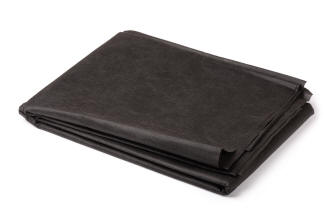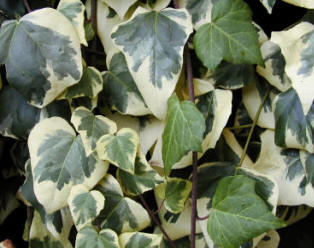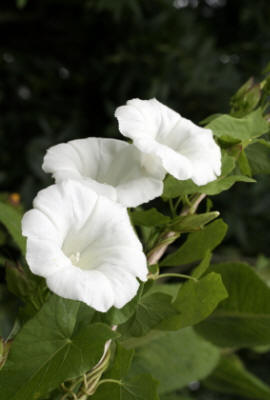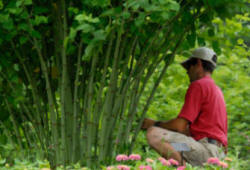
One of the biggest problems that confronts the gardener - and even puts many people off gardening - is that of weeds in the garden. It need not be so. All you have to do is understand what a weed is, what it wants from life, and most importantly - what it needs in order to thrive.
Walk through any area where there is a range of gardens, and it soon becomes apparent that some gardens have weeds, whilst others do not! Once we understand why this is so, then weed control or even total eradication of weeds becomes a reality.
The best way is to eradicate the weeds before they start growing, if you were to turn over your soil with a spade or fork, even though you won’t be able to see most of them, there are almost certainly thousands of weed seeds in it.

Seed Bank
This is called a "Weed Seed Bank", we can get scientific about this, but to keep things simple each of the seeds and weeds in this bank are alive and waiting for the right conditions to germinate and grow. They can lay dormant for seasons or years and when it is their time, they will pop up.
Why is it important that we eradicate weeds? Is it just because they do not look nice? (they are a living plant with some purpose in life). Weeds tend to be stronger than some of our delicate plants and they will steal the nutrients needed for our delicate plants which will cause them to starve in growth and they can kill them by starvation.
So how can we eradicate weeds before the start to grow?
There are two main methods when we are starting a garden or area from scratch; Mulch methods (Mulching does not kill weeds, it keeps the weeds dormant) and Chemical Weed Killers, for established gardens and the organic gardener we still have the Mulch method and the back breaking manual methods of removing Weeds.

Garden Weeds
Weeds are plants which generally have a single advantage over most garden plants. They seem to have the ability to grow well in any space available to them, seemingly without the water or food that our normal garden plants find such a necessity in order to survive. It is often overlooked – or ignored – that these weeds are simply taking over neglected areas of the garden.
Do not think that you can simply plant ground cover planting among established weeds. The weeds should either be dug out or treated with Weedol (Paraquat) or Tough Weed-killer (Glyphosate) and the area planted only after the weeds have died back. Then the plants can become established and form a dense canopy which will be the basis of your ground cover planting scheme.
An alternative to chemical weed control in the garden is to use a ground covering plastic sheet which will effectively stop new weeds from growing through. The sheet is best left in place for a month or so - depending upon the weeds below. After its removal, planting can take place. Alternatively, the sheet can be left in place - as long as it is of material that allows water through to the soil below, but simply blocks out the light.

Mypex Sheet
The downside being, that you have to cut holes in the sheet to plant your plants. Pernicious weeds have a habit of finding these gaps and are happy to grow up though the holes cut out for your plants. Another bane being, that by using the method of planting through a sheet cover, the sheet will have to be covered with some type of mulch to hide it from view. Possible on flat ground, but not on slopes! It is far better to get the soil free of weeds - either by sheet control or chemicals first. Then any mulch added after planting, will benefit the soil, and generally stay where put!
As well as physical means of getting rid of weeds, there is a huge range of weedkillers to help you to overcome the problem they represent.
There are chemical controls - weedkillers - for virtually all weeds known to gardeners. Some of them seem to work, and others do not. Could it be that they are not being used correctly? Failure or damage with weedkillers can nearly always be traced to the incorrect application - either by wrong mixing, or by using at the wrong time of the year.
Older macadam driveways can be lifted and ultimately ruined with troublesome perennial weeds such as thistles pushing their way through the tarmac surface, or even breaking the surface of a weak concrete or paved drive.
Old and poorly constructed walls can be home to a range of weeds - or even garden plants! The roots can soon loosen old mortar and eventually lead to the de-stabilisation of the wall. Plants purposely planted in a dry-stone wall are one thing; A Buddleia rooting into a wall is quite another, so the Buddleia then becomes a weed rather than colourful shrub.

How to Kill Ground Elder
Without doubt, Ground Elder is one of the mast hated weeds to be found in the garden. This includes Ground Elder in lawns, which in spite of being mown regularly is is quite a persistent pest.
Your own garden can be well cared for and spick and span, but then suddenly from under the dividing fence, Ground Elder can creep through from a neglected neighbour’s patch.

Ivy Plants
Ivy growing up trees, ivy up walls, ivy in and around the shrubs, coming in from the neighbour's garden etc! Most of us will have experienced this problem weed at some time in our gardening lives. Yet it can be killed - dead and gone!
There are two basic ways to kill Ivy and its roots. (Forget about digging it out unless it is just a mite of a plant). The best time to tackle ivy is in the late winter - just before the spring growth starts.

Jimson Weed ~ Datura Stramonium
Datura Stramonium is a Poisonous Weed, its seeds are extremely poisonous coming from the Nightshade Family, it also contains Atropine, Hyoscyamine, and Scopolamine used in modern medicine and its leaves contains Tropane Alkaloids which is a Hallucinogenic Drug.
Datura Stramonium has many common names, mainly in the UK / USA it is called Jimson Weed or Thorn Apple and dates back to 1676. Originated in Central America, probably Peru, Jimson Weed was first recorded in Jamestown, Virginia, 1676

Bindweed
Bindweed and Bellbind are very similar, so the methods used to kill or control them are also similar Bindweed - Convolvulus arvensis - is one of our top ten garden weed pests. It need not be so, for it is quite simple to kill. However, it does take a bit of patience and above all - willpower (neither of which can be bought in handy ready to use spray guns!).
One big problem with killing or controlling Bindweed is the fact that its habit of growth makes it difficult to isolate in order to use a chemical weedkiller. It is often to be found twining its way through shrubs, hedges and other garden plants. This makes the application of a suitable weedkiller to the foliage rather difficult, for the same weedkiller will also kill - or at least severely harm - the cultivated plants that in comes into contact with.

Japanese Knotweed
Japanese Knotweed has been around for years. Many many years, for as a young boy, I used to use the hollow stalks for peashooters. My friends also used to 'smoke' the dead stalks in the winter, but that is another story!
Nowadays - some 55 years on - it has become public enemy number one insofar as weeds are concerned - it is not easy to kill or control! No longer a toy, but now a serious menace - so much so that there are strict rules (laws) governing what you can and cannot do if you have the wretched weed!

Stinging Nettles
Stinging nettles - Urtica dioica -usually populate uncultivated ground, but often find their way into gardens - particularly around the edge of cultivated areas, or at the base of walls. Whilst they are nasty plants to handle and deal with, they are relatively easy to kill - either by chemical or cultivation methods.
It is as well to understand a little about stinging nettles before deciding which way to go about killing it. Most will be aware that they can give rather nasty stinging rash, and this will develop into quite a severe problem with repeated exposure. Dock leaves rubbed on the affected areas are said to alleviate the pain. Try it and see! Far far better to avoid being stung in the first place.

Weedkillers
If there is one area that the gardening trade could improve their 'customer friendliness' then it has to be the proper explanation and provision of weedkillers.
The Gardenseeker mailbox is frequently 'visited' by someone who has just killed off most of their garden or lawn, with either the wrong choice of weedkiller or the wrong application.

Herbicide Damage
This is a list of herbicides, weedkillers, and the types of injuries that may be caused when they come into contact with sensitive plants: The damage from weedkiller and herbicide application can be rectified to a certain extent, depending on the type of weedkiller used.